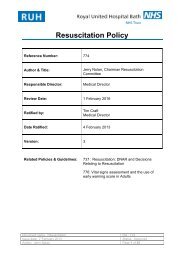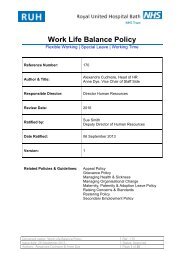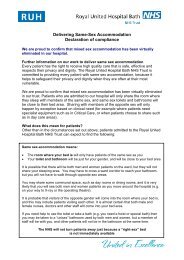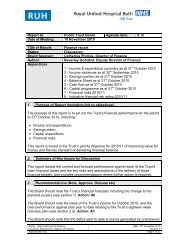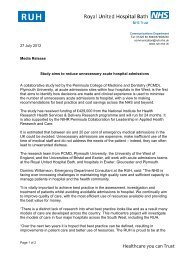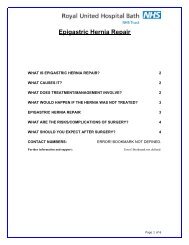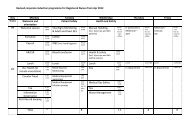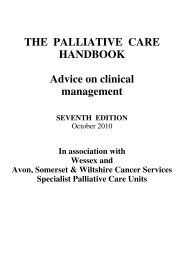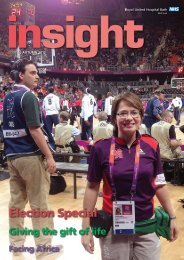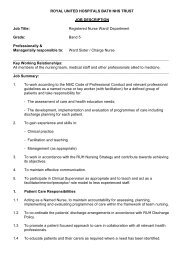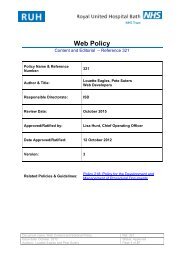(NPWT) including Vacuum Assisted Closure (Vac) - Royal United ...
(NPWT) including Vacuum Assisted Closure (Vac) - Royal United ...
(NPWT) including Vacuum Assisted Closure (Vac) - Royal United ...
You also want an ePaper? Increase the reach of your titles
YUMPU automatically turns print PDFs into web optimized ePapers that Google loves.
10. Patients with open abdomens<br />
• The open abdomen is a technique also known as laparostomy, in which the<br />
fascia is left open intentionally to avoid elevation of intra-abdominal pressure and<br />
where surgical re-exploration is desirable. Temporary abdominal closure can be<br />
achieved using a dressing or technology intended to protect the exposed viscera<br />
(KCI, 2009; Garner, 2001).<br />
• The abdominal dressing <strong>NPWT</strong> system can assist to stabilise the abdominal<br />
wall, quantify and collect exudate, protect the intra-abdominal viscera and keeps<br />
the fascia intact and the cutaneous plane for subsequent closure (Caro et al.<br />
2011).<br />
• Patients with open abdomens must be referred to the TVN via Millennium within<br />
24 hours for consideration of specialized <strong>NPWT</strong> pumps & dressings designed<br />
specifically for the open abdomen.<br />
• Ward staff will not perform <strong>NPWT</strong> assessments or apply <strong>NPWT</strong> to the open<br />
abdomen, this must be managed by the patients’ consultant with appropriate<br />
involvement of the TVNs. Each patient will be managed individually (KCI, 2009).<br />
• All patients with <strong>NPWT</strong> insitu over an open abdomen who are well enough to<br />
mobilise should be assessed for corsetry and mobilized cautiously. This is to<br />
ensure that the <strong>NPWT</strong> seal is maintained.<br />
• For further information on the open abdomen and <strong>NPWT</strong>, please refer to the<br />
‘Clinical guidelines for the management of the open abdomen with KCI systems<br />
for active abdominal therapy’ (KCI, 2009) (See Tissue Viability intranet site).<br />
11. Consent<br />
• Verbal consent must be gained from the patient and this will be documented in<br />
the patient’s medical notes.<br />
• A patient information leaflet should be given and discussed with all appropriate<br />
patients and carers and is available on the Tissue Viability intranet. Patients<br />
MUST be monitored for any signs of bleeding and be educated on the<br />
importance of seeking assistance promptly in the case of haemorrhage (FDA,<br />
2009; 2011).<br />
Document name: Negative Pressure Wound Therapy (<strong>NPWT</strong>) Ref.: 745<br />
Issue date: 10 June 2013<br />
Status: Approved<br />
Author: Kate Purser and Nicola Heywood Page 10 of 20



